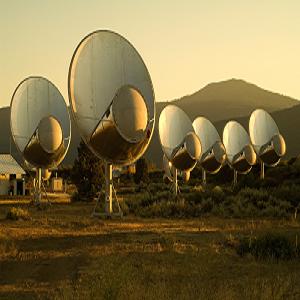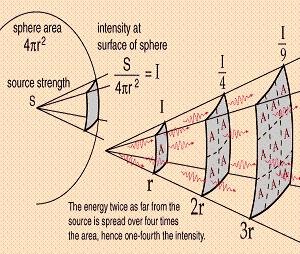Digital Transitions, Digital Transmissions, and SETI
 | | The Allan Telescope Array: when completed, it will increase SETI's efficiency by no small degree |
SETI, the non-profit organization using massive arrays to search the skies for artificial electromagnetic signals from space, is based on a simple and compelling assumption: if there is an intelligent alien civilization out there, it probably develops science and technology in much the same way we do. Granted, this assumption could be wrong, but since our current sample size is one (ourselves), it is the only useful assumption we can make. This means that, once a civilization reaches a certain point, like we did less than a century ago, it will start transmitting signals that can be strong enough to reach distant stars and planets.
I recently read an article by Kent Pitman that discusses the potential problems implied by the digital transition, the world-wide process, already underway, of eliminating analog television broadcasting in favor of digital television. Here in the U.S., the full conversion will be completed on June 12 of this year, but several other countries are either in the process or have already finished (Germany was the first). Pitman asserts that, due to the fact that highly compressed digital transmissions are indistinguishable from random noise, SETI faces a serious challenge.
In short, the idea is that, as our technology is in the process of switching from wide-bandwidth analog to highly compressed digital transmissions of all kinds (not just television) and since an advanced civilization would probably undergo the same transition, SETI is currently only going to find civilizations in the tiny slice of time between discovering radio and going digital.
 | | Physics is fun! |
On the surface, this is a compelling argument, but there are a few false assumptions worth noting. First of all, Pitman's argument could be an understatement, as the signals we have been sending out since the early twentieth century would be undetectable using our own instruments. In other words, if there were a civilization right next door to us (say within a few dozen light years) and it were in exactly the same stage of development as we are, we would never know, even if we pointed all of our arrays and tranceivers right at it.
The problem is that electromagnetic radiation (which is what we're talking about here), when unfocused, travels outward in a sphere. As one can see mathematically using the inverse square law, it gets much weaker the farther it travels. By the time a signal from Earth reaches our nearest neighbor, Alpha Centauri, which is only 4.37 light years away, it would be roughly 1/74,000,000,000th as strong as it was when it reached our sun. This is an oversimplification of the physics, but it's accurate enough to demonstrate the situation; an alien signal would have to be really strong for us to be able to detect it.
The only other way we'd receive an alien signal is if the transmitter were focused and directed straight at us, which would probably only happen if the aliens were aware of us and were eager to communicate with us across the chasm of spacetime. Again, we here on Earth have only done this once, and the signal we sent out back in 1974 won't reach its destination, the globular star cluster M13, for about 25,000 years. It should be noted that, from an outside observer, our solar system is very uninteresting, especially when it is compared to M13.
 | | The M13 Globular Cluster: way more interesting than Sol |
Our only real hope is that the alien civilization could somehow detect our existence. We here on Earth are only just starting to detect large planets around nearby stars (the smallest being twice the size of Earth and highly unlikely to be cool enough for life), and it may be a long time before we develop the techniques and technologies to see smaller planets. It will take even longer for us to detect life. Therefore, using the SETI assumption, the only alien civilization we could hope to find would have to be much more advanced than us. It would also have to be interested enough in us to send a greeting. Therefore, we have to ask ourselves, are we really that fascinating?
But the bigger question Pitman illustrates is, would we be able to distinguish the signal from everyday interstellar noise?
Luckily, the answer is probably yes. It's true that modern SETI uses pattern recognition in hopes of finding an alien signal and that a compressed digital signal would not contain any patterns we would recognize. However, this is only one of many criteria SETI uses. One of their primary concerns, in fact, is a narrow bandwidth, not a broad one as Pitman suggests. Any signal using a bandwidth less that 300 Hz would most likely be alien in origin, since we know of no natural processes that could create such a signal.
Additionally, SETI also looks at potential broadcasts in the microwave frequency band, since it is a relatively quiet part of the spectrum that contains a natural emission line thanks to interstellar hydrogen. If a strong enough signal were found in this range, even if the signal were seemingly random, it would get SETI's attention.
 | | I'm seriously sick of being asked this question by my cable television! |
SETI also looks for other anomalous characteristics, such as signals that are completely polarized. In short, despite the fact that the digital transition does hint at a potential stumbling block in SETI's calculations, it does not mean that their search is futile or that it presents a challenge big enough to justify a restructuring. Besides, if an alien civilization really wanted to communicate with us, they'd probably want to make it as easy as possible for us to recognize their signal.
In some respects, even, the digital transition could be a good thing for SETI. If an alien technology is sending out hugely compressed digital signals, it would actually be easier for us to detect than a larger signal, since we are specifically looking for compressed signals. Then again, if there were a massively powerful broadcast all over the spectrum headed in our direction for a long period of time, it'd be hard for us to miss it.
And as our own technology grows, we will get more adept at searching the skies. Who knows, maybe one day we can even detect broad-spectrum transmissions from far away. Maybe we'll find a civilization out there that just recently discovered radio, and then we can send a signal its way. By the time the signal reaches the alien planet, the aliens will probably be smart enough to detect the signal and send one back. The sheer potential of such an event is justification enough for SETI to continue.
Then again, we might also be invaded by self-replicating alien nanobots and become food for their doomsday machines.
-e. magill, 03/23/2009
|
|